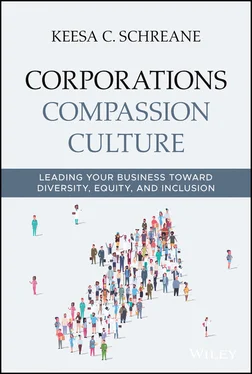1 ...8 9 10 12 13 14 ...17 21 21. https://greatergood.berkeley.edu/article/item/why_compassion_in_business_makes_sense
22 22. https://qz.com/627435/corporate-attempts-to-quantify-empathy-show-just-how-little-companies-value-it/
23 23. https://www.gallup.com/workplace/236366/right-culture-not-employee-satisfaction.aspx
24 24. https://www.carnegie.org/about/our-history/gospelofwealth/
25 25. https://www.history.com/shows/men-who-built-america
26 26. https://www.vox.com/the-goods/2019/9/5/20849632/uber-public-relations-crisis-qanda
27 27. https://www.cnn.com/2019/11/06/tech/uber-stock-lockup/index.html
28 28. https://www.npr.org/2016/10/04/496508361/former-wells-fargo-employees-describe-toxic-sales-culture-even-at-hq
29 29. https://money.cnn.com/2016/09/26/investing/wells-fargo-stock-fake-account-scandal/index.html
30 30. https://www.google.com/search?q=wells+fargo+stock+price&rlz=1C1LENN_enUS539US542&oq=wells+fargo+stock+price&aqs=chrome¨69i57j69i59j0l6.7198j0j9&sourceid=chrome&ie=UTF-8
31 31. Schultz, Howard. Pour Your Heart into It (New York: Hachette, 1997).
32 32. https://www.nydailynews.com/news/national/starbucks-manager-called-cops-minutes-black-men-arrive-article-1.3942931
33 33. https://www.businessinsider.com/starbucks-ceo-apology-black-men-arrested-viral-video-2018-4
34 34. https://time.com/5294343/starbucks-employees-racial-bias-training/
35 35. https://www.usatoday.com/story/money/2018/05/26/starbucks-racial-bias-training-costly/642844002/
Chapter 2 Uncomfortable, but Necessary Connecting Racial History to Racial Injustice in Corporate Structures
When people on management teams plan and strategize to provide a good or service, they discuss expectations for the future while also examining the lessons of the past. They want to understand what led up to the present moment in the marketplace or how they built a certain reputation in a specific region or within the industry. They talk about what the marketplace expects of the brand and how they can improve marketplace engagement.
Unfortunately, when examining the relationships among groups of people who make up their organizations, they often don't take that same analytical approach. They don't, for example, probe past injustices to learn what went wrong and how they might create more equitable outcomes today. They don't explore what led to the massive levels of distrust within certain demographics toward corporate culture. In particular, an honest investigation into the history of “working-while-Black” makes corporate America deeply uncomfortable. That discomfort has stalled awareness of the perspectives of people of color in general—and Black people in particular—when it comes to their histories in the workplace. It has also stalled progress toward equality.
The discomfort is understandable but unproductive, because these explorations are valuable to understanding our perceptions of each other in the workplace, as well as how we choose to validate our experiences and contributions, especially those of people of color. Clear and honest views into the past are needed to solve the present tensions between people of color and the corporations they work for. Truth is, Black people have a lot of reason to be skeptical of corporate culture.
I recall a point earlier in my career when I thought I was being “managed,” when in fact I was being managed out of the firm. A manager who'd been with the company for decades, but who just took over as my manager, shared with me that he had gone to other stakeholders to collect information on me specifically to get their thoughts on where I was not delivering. There was no context. There were no examples to back up stakeholder comments. There was no opportunity for me to be part of those meetings. There was the fact that I was the only Black on the team. There was the fact that I experienced continuous isolation. There was the fact that the scenario boiled down to the word of one White male senior manager to another White male senior manager, who shared a long, positive relationship with each other. His ambition was to hand me a pink slip, and longevity of tenure was on his side. His efforts were thwarted when he was only able to find one stakeholder out of a dozen willing to support his efforts. That was still one too many as far as I was concerned, and it created a chasm between my manager and me. I was on my guard during each interaction with him, balancing self-preservation while trying to build a network of people I could trust within the business group.
What's the point of this story, you ask? Consider the amount of time he spent attempting to recruit people to damage my professional reputation. That time could have been spent on other efforts: developing new customer retention strategies, researching the marketplace for emerging opportunities, or analyzing revenue. Instead, this manager chose to spend his time contacting several leaders to inquire about my individual performance. In turn, I spent hours on the defensive. Hours I could have invested into training myself on a new skill or prospecting new customers. Instead, I reread each of my emails with microscopic precision. I reviewed every word I might utter ahead of any encounter with him to avoid his public analysis of whether I had chosen the right phrase. Once, in front of a group of about half a dozen customers, I introduced him as head of the group. He immediately corrected me saying “No. No. I manage Keesa and the whole team.” Again, his public analysis was reserved for me alone.
This environment did not invite me to speak up with new ideas. He wasn't challenging my ideas, scrutinizing them, or asking for a clearer hypothesis. These were blatant, repeated attempts to shut me down before I even reached the idea share stage. It was nearly impossible for either of us to focus on peak productivity under these circumstances, creating a lose-lose situation.
Of course, that's just one anecdote. But I can say with a high degree of confidence that every person of color in the corporate workforce has not just one but multiple anecdotes that are similar and, oftentimes, worse. Ultimately it's not a question of any single person's subjective experience. The problem is much larger, and runs deeper, than the experiences of one.
This chapter examines the historical basis for the distrust that people of color, and particularly Black employees, often feel toward business and business leaders, including examples and concepts related to these issues:
The Black American working experience
Entrepreneurship
People of color in leadership today
Colorism infiltrates global corporate environments
Corporate America's workplace racism, rooted in slavery
The Black American Working Experience
The entire history of working-while-Black offers example after example of why Black people continue to feel unwelcome in the workplace and/or skeptical of White management. From the beginning, the working world has been treacherous waters for Blacks specifically, who could experience oppression, violence, or even death for just trying to do their jobs. It can be tempting to wave away this history, declaring that the working world has changed—that, in particular, working-while-Black has changed. But the history of injustice in working-while-Black hasn't gone away. The reality is that distrust, abuse, and violence in the workplace is a part of a larger legacy. To deal with the present lack of compassion, equality, and inclusion at work, we must understand its origins. Knowledge of the past will help us steer toward a better future for business culture.
The first Americans to work-while-Black were of course the enslaved people kidnapped from their homes in Africa and brought to our shores under some of the most horrific conditions imaginable. But the end of slavery did not mean the end of the exploitation of Black labor. As noted by W.E.B. DuBois, “the slave went free; stood a brief moment in the sun; then moved back again toward slavery.” Violence toward and exploitation of the Black labor force dates back to the 19th century. It began as soon as the slaves were set free and benefited the overall national economy. When the 13th Amendment to the US Constitution was ratified, it said there should be no slavery and involuntary servitude, except as a punishment for those convicted of a crime . In the South, an economy devastated by civil war, some White citizens responded by adopting forced labor as punishment for petty crimes or crimes that were vague and subjective. This was an early example of how some in power redefined the law to benefit themselves, demonstrating egregious ethical conduct. Further, some states and entities subjugated Blacks through intimidation and the use of disposable labor: as many as 200,000 Black Americans were forced into back-breaking work in factories and mines, living in subhuman conditions, starved, beaten, flogged, and sexually violated. They died by the thousands. 1
Читать дальше












